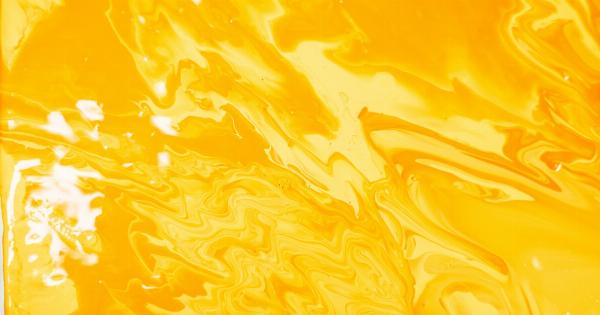Having a bright, white smile can boost your confidence and overall appearance. Unfortunately, many people struggle with yellowing teeth, which can be caused by various factors such as aging, genetics, poor dental hygiene, and certain lifestyle choices.
While it is natural for teeth to lose some of their whiteness over time, there are certain habits and substances that can accelerate the yellowing process.
The Culprits: What Causes Yellowing Teeth?
Before we delve into what to avoid to prevent further yellowing of teeth, it’s important to understand the common culprits behind this dental issue:.
1. Tobacco Products
Smoking cigarettes or using other tobacco products is not only detrimental to your overall health but also to the color of your teeth. Tar and nicotine found in tobacco stain teeth and cause them to turn yellow over time.
Moreover, tobacco use increases the risk of gum disease, which can further contribute to yellowing teeth.
2. Poor Oral Hygiene
Inadequate oral hygiene practices such as infrequent brushing, improper flossing, and irregular dental check-ups can lead to plaque buildup, which can stain the teeth.
Plaque contains bacteria that produce acids when they come into contact with sugars in the mouth, promoting tooth discoloration and decay.
3. Food and Drinks
Certain food and drinks can leave stains on your teeth, causing them to lose their whiteness. Some of the biggest culprits include:.
a. Coffee and Tea
Both coffee and tea contain tannins, which are a type of pigment-producing compound. These tannins can stick to the enamel of your teeth, leading to noticeable discoloration over time.
b. Red Wine
Red wine, although enjoyed for its rich flavors, can leave behind dark stains on your teeth due to its intense pigmentation.
Additionally, its acidic nature can weaken the enamel, making your teeth more susceptible to staining from other foods and beverages.
c. Colored Soft Drinks
Carbonated beverages and soft drinks that are high in sugar content and artificial coloring can discolor your teeth. The combination of sugar and color additives can lead to yellowing and even tooth decay if consumed excessively.
d. Berries
While berries are packed with antioxidants and nutrients, they can also leave stains on your teeth due to their vibrant colors.
Blueberries, blackberries, and other deeply pigmented berries have the potential to discolor your teeth if consumed in large quantities or not cleaned properly afterwards.
4. Medications
Some medications, particularly those containing tetracycline and doxycycline, can cause intrinsic tooth discoloration.
These medications are known to affect tooth development and result in teeth appearing gray or yellowish, especially in children who take them during their formative years.
5. Aging
As we age, the enamel on our teeth naturally becomes thinner, revealing more of the yellowish dentin underneath.
This gradual thinning of the enamel is a normal part of the aging process and is compounded by other aging factors such as wear and tear from daily use and exposure to staining substances over time.
The Dangers of Teeth Whitening Fads
When individuals become self-conscious about the yellowing of their teeth, they may turn to various teeth whitening fads and products that promise quick and dramatic results.
While some of these options may offer temporary improvements, they may also have potential risks and adverse effects:.
1. Harsh Chemicals
Many over-the-counter teeth whitening products contain bleaching agents such as hydrogen peroxide or carbamide peroxide.
While safe to use in moderation, excessive and improper use of these chemicals can damage the enamel, leading to tooth sensitivity, gum irritation, and uneven whitening.
2. Abrasive Scrubs
Some whitening toothpastes and DIY remedies involve using abrasive scrubs or mixtures that claim to remove stains.
However, these methods can be too harsh on the enamel, causing it to wear down and expose the dentin, which can further contribute to tooth discoloration and even increase sensitivity.
3. Charcoal-based Products
Charcoal toothpaste or activated charcoal powders have gained popularity as natural teeth whitening solutions.
However, research on their effectiveness and safety is limited, and the abrasive nature of charcoal particles can potentially erode the enamel and damage the gums if used excessively or improperly.
Preventing Further Yellowing: What to Stray Away From
1. Avoid Tobacco Products
If you are a smoker, quitting smoking or using tobacco products can significantly improve the color of your teeth, in addition to providing numerous other health benefits.
By eliminating tobacco from your life, you can prevent further yellowing of your teeth, reduce the risk of gum disease, and improve your overall oral health.
2. Practice Good Oral Hygiene
Adopting and maintaining a proper oral hygiene routine is paramount to preventing teeth discoloration. Follow these tips to keep your teeth looking their best:.
a. Brush Twice a Day
Brush your teeth at least twice a day using a soft-bristled toothbrush and fluoride toothpaste. Make sure to use gentle circular motions and spend at least two minutes thoroughly cleaning all surfaces of your teeth.
b. Floss Daily
Flossing once a day helps remove plaque and debris from between the teeth that brushing alone cannot reach. Be gentle while flossing to avoid gum irritation or bleeding.
c. Rinse with Mouthwash
Use an antimicrobial mouthwash to reduce bacteria in your mouth and freshen your breath. Look for a mouthwash that is alcohol-free to prevent dryness and irritation.
d. Visit Your Dentist Regularly
Regular dental check-ups and professional cleanings are essential for preventing yellowing teeth and maintaining optimal oral health.
Your dentist can remove stubborn stains, check for any underlying dental issues, and provide personalized advice on oral hygiene practices.
3. Limit Consumption of Staining Foods and Drinks
While it may not be realistic to completely avoid certain foods and beverages that stain teeth, it is advisable to limit their consumption and take preventive measures. Consider the following tips:.
a. Use a Straw
When drinking beverages like coffee, tea, or colored soft drinks, use a straw to minimize contact with your teeth. This helps reduce the amount of staining compounds that can stick to your enamel.
b. Rinse Your Mouth
After consuming foods or drinks known to stain teeth, rinse your mouth with water or drink plain water to help wash away any residual pigments.
c. Practice Good Oral Hygiene After Meals
Brushing your teeth or at least rinsing your mouth with water after eating staining foods can prevent the pigments from adhering to your teeth for prolonged periods.
4. Be Cautious with Medications
If you or your child are prescribed tetracycline or doxycycline medications, it is essential to discuss with your dentist or pediatrician the potential effects on tooth discoloration.
They may recommend alternative medications or advise on preventive measures, such as more frequent dental cleanings, to mitigate the impact on tooth color.
5. Consider Professional Teeth Whitening
If you are unhappy with the current color of your teeth or want a more noticeable improvement, consider professional teeth whitening performed by a dental professional.
This option ensures safety and effectiveness, as the treatment can be tailored to your specific needs and monitored for potential side effects.
Conclusion
While yellowing teeth can be a common concern, understanding the causes and taking preventative measures can significantly slow down or prevent further discoloration.
By avoiding tobacco products, practicing good oral hygiene, limiting consumption of staining foods and drinks, being cautious with medications, and considering professional teeth whitening, you can maintain a bright, white smile that boosts your confidence and overall oral health.





























